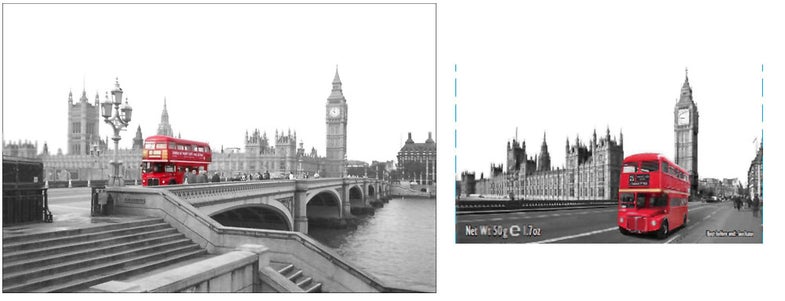UK Ruling Says Similar Composition Enough Violate Copyright
Two pictures of buses on Westminster Bridge have created a legal precedent that similarity is enough to infringe copyright.

How similar are the images above? Think they’re close enough to be a copyright infringement? A UK judge believes so, and his ruling could have some major repercussions for photographers and advertisers. Of the two shots above, the one on the left was taken by Temple Island Collections, who sell tourist merchandise in London. The image is popular enough that they have an entire area of their online store devoted to it, and the photographer claims 80 hours of work went into taking and touching the image.
The image on the left is from New English Teas, who used their image on the lid of a tea-tin. Unlike Temple Island, the New English image is actually a combination of three photos of the Houses of Parliament, one of the bus, and another stock photo of the bus. All of these pictures were combined into a single image, for use by the tea seller. They use a large amount of color key photography in their packaging, putting iconic images of London on their boxes and tins.
Obviously, the photos are different, while being stylistically very similar. As pointed out on Reddit, color key shots of busses passing over Westminster Bridge are remarkably common.
You can read the entire judgment online, but much of this ruling comes down to the view that the composition of the photograph is art in photography. As the ruling states:
Even in cases where it’s a very popular shot (like the Houses of Parliament), the act of composition is what differentiates between shots. What’s also important to note is that the question of prior knowledge arises with this ruling. The defendants admit that the tea company knew of the Temple Islands image, and the judge ruled they set out to mimic it:
This ruling will no doubt raise the hackles of most photographers, as it is sweeping and can be seen to lay a dangerous precedent. After all, there are a standard repertoire of shots that get used, especially in a professional setting. If a wedding photographer didn’t capture the first kiss at the altar, they’d be likely to be drawn and quartered by their clients, and this ruling seems to suggest that such a shot could be under copyright.
But the judge’s ruling relies on the defendant having both prior knowledge of the existing photograph, and be attempting to mimic it — which substantially narrows the power of the ruling. However, it means that if such charges were brought against a photographer, they’d have to fight a legal battle to prove that these things weren’t true. My worry is that this sets a precedent like you see with British libel law, whereby it’s extremely easy to allege, and difficult and expensive to defend, which causes many companies to fold rather than fight.
Curiously, the judge also specifically ruled that the chances of purchasers confusing the products did not matter in this case. Unlike, say, when Cadbury trademarked the color purple on the grounds that other confectionairs might use it and trick customers into buying the wrong product, the judge decided that that was not the issue at play here — that it’s solely a copyright violation, regardless of customer confusion.
[via Amateur Photographer]